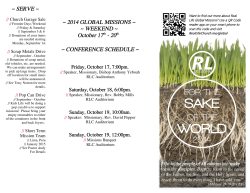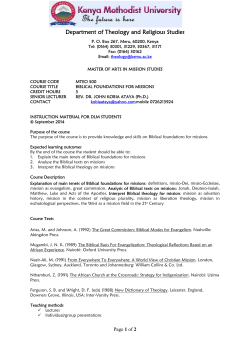
Friday, November 7, 2014 PLENARY SESSION IV Chairs:
Friday, November 7, 2014 PLENARY SESSION IV 9:00 a.m. / Building 34 -Conference Room W150 Chairs: C. Webster (JPL) C. Nixon (GSFC) 9:00 a.m. C. J. Alexander * Humanity’s First Attempt to Land on A Comet, November 2014 TECHNOLOGY FOR IN-SITU ANALYSIS AND SAMPLE RETURN (I) 9:30 a.m. / Building 34 -Conference Room W150 Chairs: C. Webster (JPL) C. Nixon (GSFC) 9:30 a.m. Zagarola M. V. * Hill R. W. Gagne J. R. Ultra Low Power Cryo-Refrigerator for Space [#1085] Creare is currently working to develop an innovative type of cryocooler, an ultra-low power cryocooler that utilizes a cryogenic heat sink. We recently completed the demonstration of a technology demonstration unit, which is the subject of this presentation. 9:45 a.m. Glavin D. P. * Tsou P. Anbar A. D. Baross J. Beegle L. W. et al. Plume Collection Strategies for Future Icy Body Sample Return Missions [#1012] Sample return of plume materials from Enceladus will be critical to the search for evidence of life on this potentially habitable moon. Here we focus on sample collector and containment technology development and testing needed for future missions. 10:00 a.m. Webster C. R. * Christensen L. E. Flesch G. J. Forouhar S. Briggs R. et al. Tunable Laser Spectrometers for Space Science [#1066] Tunable laser spectrometers have enjoyed a huge growth in capability for space science: for planetary missions, the International Space Station (ISS) cabin monitoring, and for In Situ Resource Utilization (ISRU) on the Mars 2020 mission. 10:15 a.m. Izenberg N. R. * FirefOx - An Oxygen Fugacity Sensor for Venus [#1074] FirefOx is a ceramic oxygen sensor designed for deep atmosphere, near surface determination of the oxygen fugacity of Venus, and constraint of stable surface mineralogy and gas chemistry. 10:30 a.m. Durga Prasad K. * Maniteja V. Murty S. V. S. A Novel Approach for Precise Temperature Measurement by Planetary Thermal Probes [#1014] We have developed and tested a novel signal conditioning scheme for precise RTD based temperature measurement by Planetary thermal probes. This scheme would help in designing an optimised electronics for in situ planetary heat flow measurements. 10:45 a.m. Gerasimov M. V. * Gas-Analytic Package of the Russian “Lunar-Resource” mission [#1036] Gas-analytic package of the Lunar-Resource mission is aimed on comprehensive investigation of the inventory of volatiles in the polar regions regolith. It uses pyrolysis-gas-chromatography-mass-spectrometry method and consists of three instruments. 11:00 a.m. Hill S. W. * Hohlfeld E. M. Adams E. A. Liang S. X. Sharma A. et al. In-Situ Small Body Surface Characterization Enabled by the Planetary Object Geophysical Observer (POGO) [#1039] The Planetary Object Geophysical Observer (POGO) is a self-contained, fully autonomous ride along payload that is able to provide in-situ elemental and compositional information of many different locations on a small body surface. 11:15 a.m. COFFEE BREAK 11:35 a.m. Arevalo R. Jr. * Brinckerhoff W. B. Mahaffy P. R. van Amerom F. H. W. Danell R. M. et al. It's a Trap! A review of MOMA and other ion traps in space or under development [#1102] Ion trap instruments have found a niche in planetary missions that require small, versatile mass analyzers. Here, a review is provided on the current state of ion trap technologies in flight and/or under development. 11:55 a.m. Thangavelautham J. * Robinson M. Taits A. McKinney T. Amidan S. et al. Flying, Hopping Pit-bots for Cave and Lava Tube Exploration on the Moon and Mars [#1087] In this paper we introduce a network of 3 kg, 0.30 m diameter ball robots that can fly, hop and roll using an on board miniature propulsion system in extreme environments such as caves and lava tubes on the Moon and Mars. 12:10 p.m. Lawrence D. J. * Burks M. T. Goldsten J. O. Peplowski P. N. Beck A. W. GeMini Plus: A Low Resource, High Precision Gamma-Ray Spectrometer for Planetary Composition Measurements [#1092] We discuss a new instrument called GeMini Plus that can accomplish laboratory quality, high-precision gamma-ray measurements with the type of low-resources needed for landed platforms as well as resourceconstrained orbital missions. 12:25 p.m. Harvey T. J. Hur-Diaz S. * Asteroid Capture with a Structured Netted Asteroid Retrieval Envelope (SNARE) [#1097] We describe an innovative asteroid capture system concept using CubeSats called the Structured Netted Asteroid Retrieval Envelope (SNARE) as a viable and compelling solution to capturing a small asteroid. 12:40 p.m. LUNCH BREAK Friday, November 7, 2014 CUBESATS CONCEPTS FOR PLANETARY MISSIONS 9:30 a.m. / Building 34 -Conference Room W120A&B Chairs: S. Felman (JPL) S. Stahle (GSFC) 9:30 a.m. Baker J. D. * Expanding Science and Innovation with CubeSat Instruments [#1150] Imagine flying through the plumes above Europa and being able to identify the composition of the ejecta without risking your primary spacecraft. Today the first low cost deep space CubeSats, called INSPIRE have been developed and more are on the way. 9:50 a.m. Farrell W. M. * MacDowall R. J. Folta D. Bradley D. Collier M. R. et al. Terminator Double Layer Explorer (TerDLE): A Plasma Lunarcube Concept [#1072] TerDLE will study the plasma expansion process at low altitudes along the flank of the lunar plasma wake. 10:05 a.m. Castillo-Rogez J. C. Blacksberg J. Feldman S. M. * Kahn C. L. Shapiro-Scharlotta A. A. Small Instruments for Nano-Spacecraft Applications - A Review [#1158] This paper provides a review of the current state of the art in small instruments that may be applicable to future missions involving independent or deployable platforms in the 1-10 kg range. 10:20 a.m. Paine C. G. * Hayne P. O. Cohen B. A. Lunar Flashlight: A 6U CubeSat Using Solar Sail Propulsion to Orbit the Moon and Illuminate PermanentlyShadowed Regions in a Search for Water [#1131] We describe a mission concept for a solar-sail—powered CubeSat to orbit the moon, illuminate permanently shadowed polar regions with sunlight reflected from the sail, and quantify the presence of cold-trapped water ice using the reflected spectrum. 10:35 a.m. Esper J. E. * Cubesat Application for Planetary Entry (CAPE) Missions: Micro-Reentry Capsule (MIRCA) [#1147] The CAPE concept describes a high-performing Cubesat system which includes a propulsion module and miniaturized technologies capable of surviving atmospheric entry heating. MIRCA is CAPE’s first planetary entry probe flight prototype. 10:50 a.m. Cooper J. F. * Sturner S. J. Sittler E. C. Paschalidis N. Wesenberg R. P. et al. "Natural Environmental Shielding Impacts on Electronics and Sensor Shielding Design for Missions to Extreme Radiation Environments of the Galilean Moons”[#1149] Natural environmental shielding impacts of Galilean moon bodies, surface topography, and magnetic fields on spacecraft and sensor electronics are considered for orbiter, flyby, and lander missions to extreme radiation environments of these moons. 11:05 a.m. END OF SESSION Friday, November 7, 2014 TECHNOLOGY FOR IN-SITU ANALYSIS AND SAMPLE RETURN (II) 1:40 p.m. / Building 34 -Conference Room W150 Chairs: M. Trainer (GSFC) S. Milam (GSFC) 1:40 p.m. Noell A. C. * Lee M. C. Takano N. Elleman D. Hasenoehrl J. et al. Astrobionibbler: Microfluidic Subcritical Water Extraction of Organics from Planetary Samples [#1100] Astrobionibbler is a microfluidic instrument meant for sample extraction and concentration of organic molecules from solid powder samples. By miniaturizing the extraction and concentration process it will enable a wide range of wet chemical analysis. 1:55 p.m. Getty S. A. * Li X. Cornish T. Grubisic A. Uckert K. et al. A Two-step Tandem Laser Time-of-Flight Mass Spectrometer for the In Situ Study of the Surfaces of Primitive and Icy Solar System Bodies [#1101] Laser desorption/ionization time-of-flight mass spectrometry offers compositional analysis of solid samples using an instrument that can be made compact, low power, and lightweight for future in situ misions to primitive bodies and icy moons. 2:10 p.m. Alerstam E. * Blacksberg J. Maruyama Y. Cochrane C. Rossman G. R. A miniature time-resolved Raman spectrometer for in situ planetary surface exploration [#1077] We present a time-resolved Raman spectrometer (TRRS) for planetary science as a means for identification and mapping of minerals even in the presence of high background fluorescence. 2:25 p.m. Parsons A. M. * Evans L. G. Karunatillake S. McClanahan T. P. Moersch J. E. et al. High Sensitivity Subsurface Elemental Composition Measurements with PING [#1108] The Probing In situ with Neutrons and Gamma rays (PING) instrument will measure the bulk elemental composition of the subsurface of any solid solar system body and is a versatile, effective tool for a host of in situ scientific investigations. 2:40 p.m. Tulej M. * Riedo A. Neuland M. Wurz P. LMS Instrument: Present State and Perspectives for Element and Isotope Analysis of Planetary Materials [#1137] The performance figures of a miniature laser abaltion/ionisation instrument (LMS) are presented and its coupling with a miniature microscope-camera (CAMAM suite) for additional complementary characterisation of the planetary materials. 2:55 p.m. Rymer A. M. * Westlake J. H. Smith H. T. Strohbehn K. Bowen K. ANIONS: Atmospheric Negative ION Sensor. [#1099] The importance and measurement of planetary atmospheric negative ion chemistry. 3:10 p.m. Núñez J. I. * Adams E. Y. Koerner L. J. Murchie S. L. Impact of Geometry on Element Abundances from X-ray Fluorescence in Vacuum: Considerations for APXS Measurements on Small Airless Bodies [#1145] We present test results of a prototype APXS instrument under vacuum to assess the impact of position geometry on element abundance measurements using x-ray spectroscopy. Results have implications for in-situ APXS measurements on asteroids or comets. 3:25 p.m. Roman M. J. * Malin M. C. Ravine M. A. Robinson M. S. Strategies for unmanned lunar rovers: Integration of teleoperation and autonomy based on field testing [#1153] We have carried out a series of rover field tests, demonstrating multiple km of range with human-in-the-loop operation (with lunar-appropriate latency) and (in separate tests) with autonomous operation. 3:40 p.m. Anderson F. S. * Whitaker T. J. Levine J. L. The Case For In-situ Dating with Geologic Context for the Moon and Mars using the Chemistry, Organics, And Dating EXperiment (codex) [#1161] The Chemistry, Organics, and Dating Experiment can identify evidence of non-terrestrial organics, and understand the history and duration of events in the solar system, placing them both in context. 3:55 p.m. END OF ORAL SESSION
© Copyright 2025

















